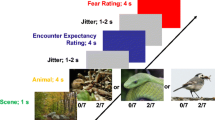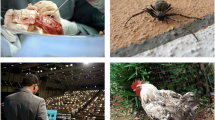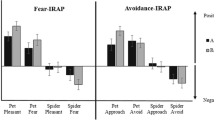Abstract
Covariation bias can be defined as phobic subjects’ tendency to overestimate the association between phobic stimuli and aversive outcomes. The current study presents two experiments that examined this type of cognitive bias in children aged 8-13 years (N=147 in Experiment 1, N=240 in Experiment 2). Children completed a self-report questionnaire for measuring spider fear and then participated in a card game in which fear-relevant (i.e., spider) and fear-irrelevant (i.e., weapon and Pokémon) pictures were equally paired with negative and positive outcomes (respectively losing and winning candy). No evidence was found for a relationship between children’s level of spider fear and the tendency to link negative consequences to fear-relevant pictures. Various methodological and theoretical explanations for this null finding are discussed.
Similar content being viewed by others
References
LG Öst (1987) ArticleTitleAge of onset in different phobias J Abn Psychol 96 223–229
BA Thyer RT Parrish GC Curtis RM Nesse OG Cameron (1985) ArticleTitleAge of onset of DSM-III anxiety disorders Compreh Psychiatry 26 113–122
E Costello A Angold (1995) Epidemiology JS March (Eds) Anxiety disorders in children and adolescents Guilford Press New York 109–124
P Muris H Merckelbach (2001) The etiology of childhood specific phobia: A multifactorial model MW Vasey MR Dadds (Eds) The developmental psychopathology of anxiety Oxford University Press New York 355–385
P Muris H Merckelbach PJ De Jong TH Ollendick (2002) ArticleTitleThe aetiology of specific fears and phobias in children: A critique of the non-associative account Behav Res Ther 40 185–195
MG Craske (1997) ArticleTitleFear and anxiety in children and adolecents Bull Menninger Clinic 61 A4–A36
O Mowrer (1960) Learning theory and behavior Wiley New York
TH Ollendick MW Vasey NJ King (2001) Operant conditioning influences in childhood anxiety MW Vasey MR Dadds (Eds) The developmental psychopathology of anxiety Oxford University Press New York 231–252
MW Vasey C MacLeod (2001) Information-processing factors in childhood anxiety: A review and developmental perspective. MW Vasey MR Dadds (Eds) The developmental psychopathology of anxiety Oxford University Press New York 253–277
C MacLeod A Mathews P Tata (1986) ArticleTitleAttentional bias in emotional disorders J Abn Psychol 95 15–20
FN Watts FP McKenna R Sharrock L Trezise (1986) ArticleTitleColour naming of phobia-related words Br J Psychol 77 97–108
M Kindt D Bierman JF Brosschot (1997) ArticleTitleCognitive bias is spider fear and control children: Assessment of emotional interference by a card format and a single-trial format of the Stroop task J Exp Child Psychol 66 163–179
M Martin P Horder GV Jones (1992) ArticleTitleIntegral bias in naming of phobia-related words Cognition Emotion 6 479–486
MW Vasey EL Daleiden LL Williams LM Brown (1995) ArticleTitleBiased attention in childhood anxiety disorders: A preliminary study J Abn Child Psychol 23 267–277
MW Vasey N El-Hag EL Daleiden (1996) ArticleTitleAnxiety and the processing of emotionally-threatening stimuli: Distinctive patterns of selective attention among high- and low-test-anxious children Child Dev 67 1173–1185
Mineka S, Tomarken AJ: The role of cognitive biases in the origins and maintenance of fear and anxiety disorders. In Aversion, avoidance, and anxiety: Perspectives on aversively motivated behavior, eds. Archer T, Nilsson LG, Hillsdale, NJ: Lawrence Erlbaum, 1989, pp. 195–221.
AJ Tomarken S Mineka M Cook (1989) ArticleTitleFear-relevant selective associations and covariation bias J Abn Psychol 98 381–394
PJ De Jong H Merckelbach A Arntz H Nijman (1992) ArticleTitleCovariation detection in treated and untreated spider phobics J Abn Psychol 101 724–727
PJ De Jong H Merckelbach A Arntz (1995) ArticleTitleCovariation bias in phobic women: The relationship between a priori expectancy, on-line expectancy, automatic responding, and a posteriori contingency judgment J Abn Psychol 104 55–62
SJ Kennedy RM Rapee EJ Mazurski (1997) ArticleTitleCovariation bias for phylogenetic versus ontogenetic fear-relevant stimuli Behav Res Ther 35 415–422
P Pauli P Montoya GE Martz (1996) ArticleTitleCovariation bias in panic-prone individuals J Abn Psychol 105 658–662
P Pauli G Wiedeman P Montoya (1998) ArticleTitleCovariation bias in flight phobics J Anx Dis 12 555–565
P Muris H Merckelbach R Collaris (1997) ArticleTitleCommon childhood fears and their origins Behav Res Ther 35 929–937
P Muris H Merckelbach C Meesters P Van Lier (1997) ArticleTitleWhat do children fear most often? J Behav Ther Exp Psy 28 263–267
M Kindt JF Brosschot P Muris (1996) ArticleTitleSpider Phobia Questionnaire for Children (SPQ-C): A psychometric study and normative data Behav Res Ther 34 277–282
HJ Eysenck SBG Eysenck (1975) Manual of the Eysenck Personality Questionnaire (adult and junior). Hodder & Stoughton London
WJ Corulla (1990) ArticleTitleA revised version of the psychoticism scale for children Pers Individ Dif 11 65–76
E De Bruyn M Delsing M Welten (1995) ArticleTitleThe EPQ-R (junior): A Dutch replication study Pers Individ Dif 18 405–411
R Scholte E De Bruyn (2001) ArticleTitleThe Revised Junior Eysenck Personality Questionnaire (JEPQ-R): Dutch replications of the full-length, short, and abbreviated forms Pers Individ Dif 31 615–625
MM Bradley PJ Lang (1994) ArticleTitleMeasuring emotion: The Self-Assessment Manikin and the semantic differential J Behav Ther Exp Psy 25 49–59 Occurrence Handle10.1016/0005-7916(94)90063-9 Occurrence Handle1:STN:280:ByqD2M7lvVE%3D Occurrence Handle7962581
MG Craske (2003) Origins of phobias and anxiety disorders Why more women than men? Elsevier Science Oxford
AO Hamm D Vaitl PJ Lang (1989) ArticleTitleFear conditioning, meaning, and belongingness: A selective association analysis J Abn Psychol 98 395–406
RJ McNally TF Heatherton (1993) ArticleTitleAre covariation biases attributable to a priori expectancy biases? Behav Res Ther 31 653–658
PJ De Jong P Muris (2002) ArticleTitleSpider phobia: Interaction of disgust and perceived likelihood of involuntary physical contact J Anx Dis 16 51–65
PJ De Jong (1993) ArticleTitleCovariation bias in phobia: Mere resistance to pre-experimental expectancies? Behav Ther 24 447–454
RV Kail (1998) Children and their development Prentice Hall Upper Saddle River, NJ
J Piaget (1970) Piaget’s theory PH Mussen (Eds) Carmichaels’s manual of child psychology: Volume I Wiley New York
CG Last S Perrin M Hersen AE Kazdin (1998) ArticleTitleA prospective study of childhood anxiety disorders J Am Acad Child Adolesc Psy 35 1502–1510
PJ De Jong MA Van den Hout H Merckelbach (1995) ArticleTitleCovariation bias and the return of fear Behav Res Ther 33 211–213
Author information
Authors and Affiliations
Corresponding author
Rights and permissions
About this article
Cite this article
Muris, P., de Jong, P.J., Meesters, C. et al. An Experimental Study of Spider-Related Covariation Bias in 8- to 13-Year-Old Children. Child Psychiatry Hum Dev 35, 185–201 (2005). https://doi.org/10.1007/s10578-004-6457-y
Issue Date:
DOI: https://doi.org/10.1007/s10578-004-6457-y




